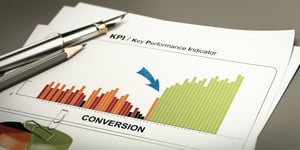 Opening a kiosk may be more affordable than launching a brick and mortar store, but you still have to make money to grow a successful business. That means you have to analyze your numbers regularly. But which retail metrics should you be looking at? What do they mean? And how can you use those key performance indicators, or KPIs, to help your kiosk thrive?
Opening a kiosk may be more affordable than launching a brick and mortar store, but you still have to make money to grow a successful business. That means you have to analyze your numbers regularly. But which retail metrics should you be looking at? What do they mean? And how can you use those key performance indicators, or KPIs, to help your kiosk thrive?
There are numerous ways to track business performance. Realistically, you cannot track every detail or you’d go crazy. And you don’t need to, because not every number is equally useful.
Here are some top retail metrics that will help you build your kiosk business:
1. Foot traffic
The more people you can attract to your kiosk, the more chances you have to sell something. It’s not as easy to count bodies around your kiosk as it would be if you had a store with a door, but you can still get a good idea. Eyeballing the crowd, while not scientific, will give you an idea over time if interest is growing and which days/times are best. Make it a habit to mentally monitor foot traffic, and keep notes so you’ll have “data” to analyze.
2. Sales volume
Foot traffic is good, but buyers are better. This is easy to track using your POS (point of sale) software. Traditional retailers track the conversion rate (the actual percentage of visitors who buy), but since you can only estimate your foot traffic, focus on comparing the trends you notice in “interested visitors” to your number of transactions. If sales volume increases faster than foot traffic, then a higher percentage of visitors are making purchases. Good.
3. Average sale
How much is each customer spending? Divide total sales by the number of transactions. Successful kiosks focus on affordable merchandise, so your average sale will be much smaller than, say, a jewelry store or a car dealer. There isn’t much you can do about this, except be sure you are not underpricing your merchandise.
4. Items per purchase
Along with average dollar amount of each sale, you want to track how many items people are buying.
You will grow your business by using clever merchandising and marketing to encourage customers to spend more by buying more. (Think upselling, cross-selling, and offering must-have impulse items.)
Note that more items doesn’t always mean higher spending. Discounts and deals can be useful, but the lower revenue per item can easily negate the increase in sales volume.
5. Gross margin and markup
These are actually two different ways to measure the same thing — the difference between your cost for an item (called cost of goods sold) and the price your customer pays. Neither one equates to your final, actual profit, because your kiosk has expenses that aren’t considered in these equations. Let’s assume your cost for the product was $80, and the customer paid $100. The calculations look like this:
Gross margin: price – cost / price, or $100 - $80 / $100 = 20%
Markup: price – cost / cost, or $100 - $80 / $80 = 25%
Markup is critical to know, because it helps you price your merchandise by simply multiplying markup by cost. In this case, that would 1.25 (your cost plus .25) x $80 = $100, the customer’s price.
6. Turnover
Employees are not “a dime a dozen.” They directly influence your sales results, and turnover can cost you in more ways than lost sales. The ideal turnover metric is zero, so focus hire carefully, train thoroughly, and treat your people well.
7. Inventory management
Unfortunately, not every item you buy to sell at your kiosk will actually get sold. Poor choices result in unsaleable left-overs, damage happens, and so does theft – by “customers” as well as employees. These losses directly reduce your bottom line. So it literally pays to implement vigilant security and inventory management technology and practices, and track inventory shrinkage to ensure protections are working.
Use your retail metrics to grow
Set a specific goal, or benchmark, for each of these KPIs for each day, month, quarter, and year. Regularly analyzing your numbers will show how your kiosk is performing over time — where you’re doing well and what areas need work to increase your kiosk success.

